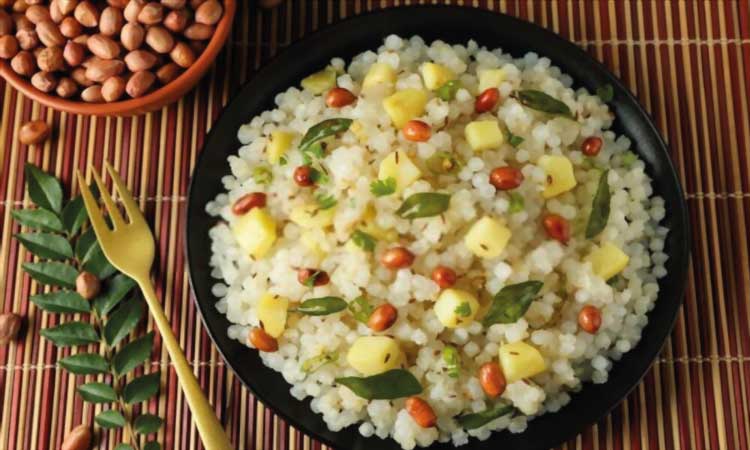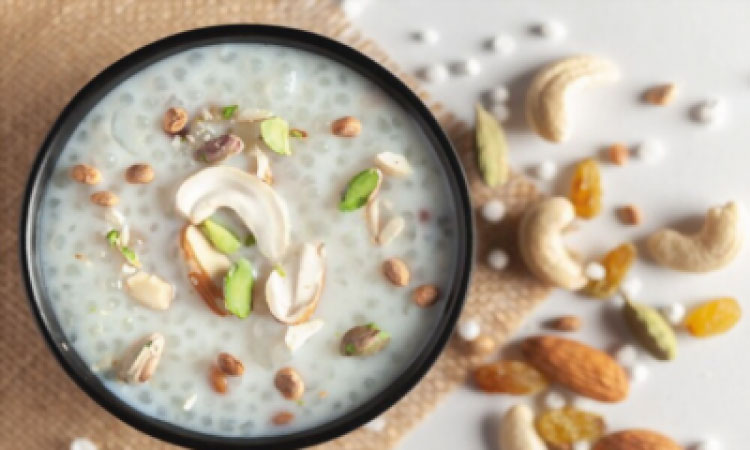You will be determined to eat healthily from the moment you find out you are pregnant. A healthy pregnancy diet includes a variety of foods that provide essential nutrients for your growing baby. We will discuss one such amazing food in this article, sabudana, or sago, during pregnancy.
Since sabudana is nourishing, low in calories, and easy to digest, it is ideal for pregnant women with digestive issues. However, there are a few things to keep in mind about the use of sabudana during pregnancy.
What Is Sabudana/Sago?
Sabudana or Indian Sago is a starchy substance derived from tapioca/cassava roots and is sometimes referred to as tapioca pearls. It has a wide range of commercial and culinary applications. It is commonly used as an ingredient in traditional Indian dishes like khichdi, puddings and soups. If you are wondering whether sabudana is a hot or cold food, the fact is that sago has a cooling effect on the body.
So how is sabudana made? The starchy juice contained in cassava roots is extracted through pressing, and the resulting liquid is then evaporated. A variety of products can be refined from the powder after dehydration, including flakes, pearls, and white flour.
Typically available in pearl form, tapioca sago can be added to milk, water, or rice to make different dishes. However, due to the high amount of starch that it contains, sabudana only offers a limited supply of the nutrients that the body needs.
Related Reading: 7 Benefits Of Drinking Milk During Pregnancy
Nutritional Profile Of Sabudana

Sabudana is predominantly composed of starch. Proteins, vitamin K, calcium, and potassium are all abundant in sabudana. It is naturally gluten-free, making it a good substitute for wheat-based products for those with wheat allergies.
According to a source, one cup of sabudana (152 grams) contains
Calculate Due Date With LMP
- Energy 544 kcal
- Carbohydrate 135 g
- Calcium 30.4 mg
- Phosphorus 10.6 mg
- Potassium 16.7 mg
- Folate 6.08 µg
- Choline 1.82 mg
Iron, magnesium, sodium, and selenium are also present in considerable amounts. Additionally, it contains traces of zinc, copper, and manganese
7 Benefits Of Eating Sabudana During Pregnancy
Sabudana, the inexpensive Indian dish also known as fasting food in India, offers several health advantages that are especially useful during pregnancy. Sabudana is rich in nutrients that are essential for a growing baby. Some of the health benefits of sabudana during pregnancy are listed below.
1. Eating sabudana during pregnancy helps with digestion
You and your unborn child will reap many benefits from eating sabudana in pregnancy second trimester. At this stage of pregnancy, constipation is a common issue. Not to mention the fact that a lot of them have problems with acidity and heartburn.
Sabudana is an excellent source of dietary fiber. This aids digestion and can alleviate symptoms like gas, constipation, and indigestion1.
2. Provides a cooling effect
Pregnant women are prone to indigestion, and hence they frequently experience a burning sensation or discomfort in the stomach. Because it is so easy to digest, sabudana makes it possible for your system to effectively flush out toxins that have built up in the body as a result of improper digestion of food.
These toxins can cause serious health problems. The cooling effect that sabudana has on the digestive tract not only facilitates digestion but also alleviates any associated burning sensation.
3. Helps combats birth defects
Sabudana also has a good amount of vitamin B complex and folic acid, which help in avoiding birth deformities in unborn babies. These elements are vital for the development of the fetus and to prevent birth defects2. Therefore, reap the benefits of sabudana during early pregnancy.
Related Reading: Green Tea And Folic Acid Absorption During Pregnancy
4. Promotes muscle growth

Sabudana is something you should consider eating as a snack because it helps build muscles. During pregnancy, eating foods that help build muscles is very important. Sabudana has a small amount of protein, but it’s enough to make up for the lack of protein in a dish that’s otherwise unhealthy.
Protein assists in repairing damaged cells and tissues and also contributes to the growth of the cells themselves as per this source.
Related Reading: Top 10 Protein-Rich Foods For Pregnancy
5. It’ll give you a boost in your energy levels
It is very common for pregnant women to experience extreme fatigue. Some pregnant women report feeling exhausted throughout their entire pregnancy, while others only experience bouts of tiredness at specific times during their pregnancy. Because it contains a good amount of carbohydrates, sabudana is an excellent source of energy, which is just one more compelling argument in favor of including it in the pregnancy diet3.
Pregnant women can benefit from eating sabudana in the morning because it will keep them energized all day long. The carbohydrates provide nearly instant energy, making it easier for the pregnant woman to navigate through the day. It is one of the important sabudana benefits in pregnancy.
6. Helps improve blood circulation
After the first few weeks of pregnancy, the body’s blood volume begins to steadily increase until delivery. Having healthy blood pressure and regular blood flow are both essential for the safe and healthy progression of pregnancy.
Related Reading: Top 9 Natural Remedies For High Blood Pressure In Pregnancy
It’s so crucial to keep your blood vessels in good shape in order to supply the placenta and the fetus with the nutrients and oxygen they need. The high amount of potassium in sabudana helps keep blood pressure at a healthy level. Sabudana is also high in iron, which helps the body make healthy red blood cells. Thus, try consuming sabudana during the third trimester of pregnancy.
7. Improves bone strength
Sabudana is helpful for pregnant women’s bone health because it contains so much natural calcium. During pregnancy, it is essential to maintain a healthy level of calcium consumption. Otherwise, the fetus will leech calcium from the mother’s bones.
Related Reading: Top 10 Calcium Rich Foods For Pregnancy
There is an increased risk of osteoporosis in the future as a result. If you want to improve the health of your bones, including sabudana in your diet is a good idea. Magnesium is an important mineral that plays a role in the process of increasing bone density in both the mother and the baby. When it comes to magnesium content, sabudana ranks high.
Other advantages of eating sabudana while pregnant are:
- When applied topically, sabudana hydrates and softens the skin while also protecting it from infections and rashes thanks to its antifungal properties
- For pregnant women whose weight gain has been less than expected, incorporating sabudana into their diets may be helpful. Sago’s high carbohydrate content makes it a great choice for underweight pregnant women
Risks And Precautions When Eating Sabudana During Pregnancy
It is not possible to consider sabudana to be a complete food. Sabudana contains a high amount of starch but only small quantities of many other vital minerals and vitamins. It is essential to compensate for these deficiencies by combining sabudana with other ingredients, such as dairy products, vegetables, and nuts, when preparing sabudana.
Related Reading: Intermittent Fasting During Pregnancy- Safe Or Not
Other precautions to take and risks to consider when using saho during pregnancy include the following:
- Sabudana should only be consumed once it has been cooked. This is due to the presence of cyanogenic glycosides, which can lead to cyanide poisoning if the Sabudana is consumed either raw or in an inadequately prepared form
- To lessen its cyanogenic toxicity, sabudana must be soaked in water and then cooked thoroughly in boiling water. The length of time that Sabudana needs to soak depends on the size of its pearls. It is recommended to soak pearls for 5-6 hours if they are large in size, but only for 2-3 hours if they are small
- Sabudana has a high glycemic index, which is a measure of how quickly a food raises blood glucose levels, so those with gestational diabetes should be careful when consuming large amounts of it. When consumed in large quantities, sabudana can cause a sharp rise in blood sugar. Women with gestational diabetes should use it cautiously
- In the event that you have thyroid issues, you should talk to your doctor before taking Sabudana
3 Ways to Include Sago In Your Pregnancy Diet

Sabudana can be prepared and eaten in a variety of different ways, such as in the form of pancakes, halwa, a shallow-fried snack, deep-fried fritters, pudding, and so on. Some women like to munch on sabudana papad during pregnancy. Sabudana itself has little nutritional value, but by combining it with other foods, you can create a more balanced and healthful meal.
Because of its versatility, sabudana can be used to make a wide variety of dishes, from breakfast to snacks and sweets.
3 ways to include sago in your pregnancy diet are:
- Sabudana Khichdi
- Sabuda Vada
- Sabudana papad
Conclusion
During pregnancy, a woman’s responsibilities extend beyond her own life to include the life of her unborn child. You will have intense cravings for certain delicious foods while you are pregnant. Sabudana khichdi and sabudana kheer are two delicious dishes that pregnant women should consider including in their diets.
These dishes can satisfy cravings for sweet, salty, or sour foods. Pregnant women and their unborn children can benefit from eating sabudana dishes because of their delicious flavor and nutritional value.
FAQs
Sabudana is high in carbohydrates, so it is good for a baby’s energy and helps them gain weight and grow taller in a healthy way.
Not at all. In fact, Sabudana is easily digestible. Constipation, bloating, and gas are all symptoms of poor digestion, and consuming sabudana aids in alleviating those conditions.


1 comment
[…] Sabudana/Sago During Pregnancy -Benefits And Precautions4 […]